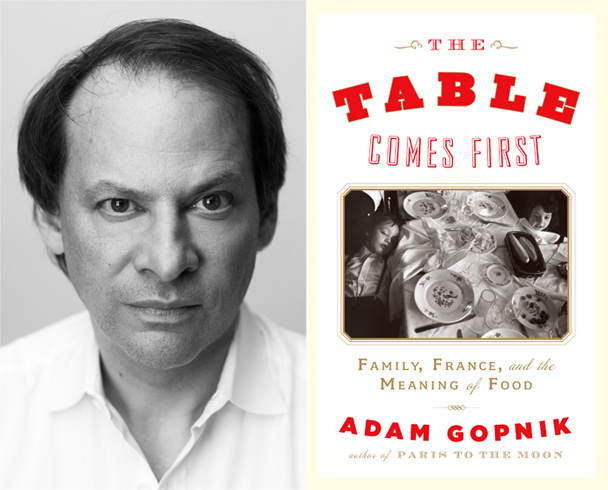Halloween came to Paris while we lived there in the mid- to late 1990s, and now seems likely to remain: A patina of pumpkins colors the streets, and while the business of kids dressing as demons to demand unearned sugar troubles what remains of the French Catholic conscience, Halloween’s essential role is to be the opening salvo of the holiday season. And though Père Noël remains ascetic-looking and gaunt compared with the rotund American materialist Santa Claus, the Christmas holiday he superintends in France is ever more like ours and less like theirs was—more of a commercial potlatch and less a feast in many ways tragic. (The baby, after all, will die; the best French Baroque Christmas music, like Charpentier’s famous “O”s, is most often sad.)
Between these two holidays comes Thanksgiving, and that was hard to find, or, for that matter, make. Thanksgiving still has no place in France, which made my wife and me sad when we lived there, because it has always been our favorite holiday. There isn’t even a word for it; or, rather, there is only a long phrase, borrowed from French Canada, where it’s a legal holiday, though celebrated much earlier in the calendar: la fête de l’Action de grâces, or the feast of the action of grace! (Though in my Canadian childhood, I never once heard it used: Thanksgiving was what it was called. In Quebec.)
We wanted to celebrate Thanksgiving in Paris because it’s always been one of our favorite holidays, for reasons that take a moment’s unpacking. In one of his early novels, Letting Go, Philip Roth has a chapter, called “The Power of Thanksgiving,” where he celebrates the November Thursday as the one high secular holiday equally open to people of faith and nonbelievers—or, more poignantly in his narrator’s case, to Jews just as much as the goyim. (Thanksgiving is a whole subject in Roth; the cruelest thing Portnoy does to his parents is not show up when he goes to college, in order to visit his girlfriend’s impeccably WASP holiday house.) That’s part of it, for me, that sense of common ownership. But it was also more personal. Thanksgiving turkey was the first big thing I ever made for company, the first dish that involved brining and roasting and basting, all those happy participles of full-time cooking engagement. Chicken breasts and filet of salmon, tortellini, and quick-fix curries—all the poky young-couple dishes had been my previous mainstays, but that was like dangling your feet in the wading pool. Thanksgiving was my first dive into the demands of making a real dinner, a feast with a small halo of grace but mostly harried action. In 1987, we invented a Thanksgiving for a collection of strays in New York—dear friends without homes nearby to go to—and it had become the best time of the year. We wanted to go on with the tradition while in Paris.
Oh, and a terrible admission, in its way: My wife loves roast turkey. Really loves it, more than any other meal—roast turkey with bread stuffing, candied carrots, Brussels sprouts, and mashed sweet potatoes, what Portnoy’s mother might have called the whole megillah. Calvin Trillin’s rueful joke about preferring something with a little more garlic—say, spaghetti carbonara—was lost on her. She truly loves the meal—it is part of the Canadian girl in her. (This is the way life is; the minx you seduced in her parents’ basement turns out to be an enforcer of Canadian recipes.) The first effort we made in Paris to have a Thanksgiving feast was to go to Allard, the old bistro on the Rue St-André-des-Arts, where we had pheasant with bacon-and-chestnut stuffing. It was good but not really Thanksgivingish, so our next move was to buy a real, full French turkey. It came complete with an explanation of its origins and was absolutely delicious. The carrots I made alongside it, too, had a crisp, orange tang, and weren’t mushy nor bland. It was a good dinner.
What we couldn’t do was get our French friends to quite see the point of the holiday, despite their patient, amused attendance. A harvest holiday? Not exactly; post-harvest really. I didn’t even want to raise the issue of the Pilgrims and Indians, since, once told, it is so clearly and chillingly a tale of a bigger swindle on the way—just sit down with us! Let’s share the table and the country! What was it that made it matter so much, absent friends and absent dishes aside? And why was it so absent not just as a holiday but also as a concept in our adopted country?
I’ve brooded on it now for years, and I think I have a piece of the answer. Holiday feasts, it seems to anthropologists—or me pretending to be one—come in two kinds: There are reversal feasts, and there are renewal feasts. (Anthropologists sometimes refer to “easy” and “uneasy” festivals to catch this distinction.) We either celebrate the world turned upside down, the reversal of our normal expectations, or we celebrate the renewal of our regular order. Halloween is the perfect example of a reversal feast: The things you are never allowed to do over the course of a year—kids going door to door, ringing doorbells, demanding treats, wearing masks—are not only allowed for one night but encouraged. The Fourth of July (or the Second of July in Canada) is the perfect example of a renewal feast. The point of these renewal feasts is to remind us of why the organization and structure of our society are the way they are—not only how they came into being but why they are revered and allowed, why they are right. New Year’s Eve is a reversal feast—license to get drunk—while Christmas is a bit of both: a reversal of the usual ritual (i.e., kids first) and a renewal of family bonds (we try and try and try to love our relatives).



 Pinterest
Pinterest


